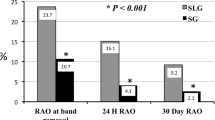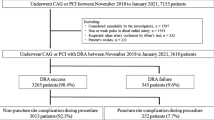Abstract
The aim of this study was to investigate the risk factors for access site-related complications after transradial coronary angiography (CAG) or percutaneous coronary intervention (PCI). Transradial PCI has been shown to reduce access site-related bleeding complications compared with procedures performed through a femoral approach. Although previous studies focused on risk factors for access site-related complications after a transfemoral approach or transfemoral and transradial approaches, it is uncertain which factors affect vascular complications after transradial catheterization. We enrolled 500 consecutive patients who underwent transradial CAG or PCI. We determined the incidence and risk factors for access site-related complications such as radial artery occlusion and bleeding complications. Age, sheath size, the dose of heparin and the frequency of PCI (vs. CAG) were significantly greater in patients with than without bleeding complications. However, body mass index (BMI) was significantly lower in patients with than without bleeding complications. Sheath size was significantly higher and the frequency of statin use was significantly lower in patients with than without radial artery occlusion. Multiple logistic analysis revealed that sheath size [odds ratio (OR) 5.5; P < 0.05] and BMI (OR 0.86; P < 0.01) were risk factors for bleeding complications; and sheath size (OR 5.2; P < 0.05) and the lack of statin pretreatment (OR 0.50; P < 0.05) were risk factors for occlusive complications. In conclusion, these findings indicate that down-sizing of the devices used in transradial procedures might attenuate access site-related complications after transradial CAG or PCI. Statin pretreatment might also be a strategy that could prevent radial artery occlusion after transradial procedures.
Similar content being viewed by others
References
Kiemeneij F, Laarman GJ, Odekerken D, Slagboom T, van der Wieken R. A randomized comparison of percutaneous transluminal coronary angioplasty by the radial, brachial and femoral approaches: the access study. J Am Coll Cardiol. 1997;29:1269–75.
Saito S, Tanaka S, Hiroe Y, Miyashita Y, Takahashi S, Tanaka K, et al. Comparative study on transradial approach vs. transfemoral approach in primary stent implantation for patients with acute myocardial infarction: results of the test for myocardial infarction by prospective unicenter randomization for access sites (TEMPURA) trial. Catheter Cardiovasc Interv. 2003;59:26–33.
Brueck M, Bandorski D, Kramer W, Wieczorek M, Höltgen R, Tillmanns H. A randomized comparison of transradial versus transfemoral approach for coronary angiography and angioplasty. JACC Cardiovasc Interv. 2009;2:1047–54.
Bertrand OF, Rao SV, Pancholy S, Jolly SS, Rodés-Cabau J, Larose E, et al. Transradial approach for coronary angiography and interventions: results of the first international transradial practice survey. JACC Cardiovasc Interv. 2010;3:1022–31.
Rathore S, Stables RH, Pauriah M, Hakeem A, Mills JD, Palmer ND, et al. A randomized comparison of TR band and radistop hemostatic compression devices after transradial coronary intervention. Catheter Cardiovasc Interv. 2010;76:660–7.
Sanmartin M, Gomez M, Rumoroso JR, Sadaba M, Martinez M, Baz JA, et al. Interruption of blood flow during compression and radial artery occlusion after transradial catheterization. Catheter Cardiovasc Interv. 2007;70:185–9.
Sakai H, Ikeda S, Harada T, Yonashiro S, Ozumi K, Ochiai M, et al. Limitation of successive transradial approach in the same arm: the Japanese experience. Catheter Cardiovasc Interv. 2001;54:204–8.
Saito S, Ikei H, Hosokawa G, Tanaka S. Influence of the ratio between radial artery inner diameter and sheath outer diameter on radial artery flow after transradial coronary intervention. Catheter Cardiovasc Interv. 1999;46:173–8.
Rakhit RD, Matter C, Windecker S, Garachemani AR, Seiler C, Eberli FR. Five French versus 6 French PCI: a case control of efficacy, safety and outcome. J Invasive Cardiol. 2002;14:670–4.
Dahm JB, Vogelgesang D, Hummel A, Staudt A, Völzke H, Felix SB. A randomized trial of 5 vs. 6 French transradial percutaneous coronary interventions. Catheter Cardiovasc Interv. 2002;57:172–6.
Masutani M, Yoshimachi F, Matsukage T, Ikari Y, Saito S. Use of slender catheters for transradial angiography and interventions. Indian Heart J. 2008;60:A22–6.
Nozue T, Michisita I, Mizuguchi I. Impact of catheter down-sizing and power injector use on the amount of contrast medium delivered. Cardiovasc Interv Ther. 2010;25:24–8.
Takeshita S, Saito S. Transradial coronary intervention using a novel 5-Fr sheathless guiding catheter. Catheter Cardiovasc Interv. 2009;74:862–5.
Tanaka A, Saito S. Percutaneous coronary intervention with a virtual 2-Fr system. Catheter Cardiovasc Interv. 2010;76:684–6.
Nakamura R, Kinoshita N, Ota K, Yamada T, Miyaki N, Matsumoto K. A successful treatment for in-stent restenosis using a 4-French guiding catheter with optical coherence tomography guidance. Cardiovasc Interv Ther. 2011;26:296–300.
Pancholy SB. Impact of two different hemostatic devices on radial artery outcomes after transradial catheterization. J Invasive Cardiol. 2009;21:101–4.
Yatskar L, Selzer F, Feit F, Cohen HA, Jacobs AK, Williams DO, et al. Access site hematoma requiring blood transfusion predicts mortality in patients undergoing percutaneous coronary intervention: data from the National Heart, Lung, and Blood Institute Dynamic Registry. Catheter Cardiovasc Interv. 2007;69:961–6.
Benamer H, Louvard Y, Sanmartin M, Valsecchi O, Hildick-Smith D, Garot P, et al. A multicentre comparison of transradial and transfemoral approaches for coronary angiography and PTCA in obese patients: the TROP registry. EuroIntervention. 2007;3:327–32.
Cantor WJ, Mahaffey KW, Huang Z, Das P, Gulba DC, Glezer S, et al. Bleeding complications in patients with acute coronary syndrome undergoing early invasive management can be reduced with radial access, smaller sheath size, and timely sheath removal. Catheter Cardiovasc Interv. 2007;69:73–83.
Doyle BJ, Ting HH, Bell MR, Lennon RJ, Mathew V, Singh M, et al. Major femoral bleeding complications after percutaneous coronary intervention: incidence, predictors, and impact on long-term survival among 17,901 patients treated at the Mayo Clinic from 1994 to 2005. JACC Cardiovasc Interv. 2008;1:202–9.
Meis A, Osada N, Schlegel PM, Fischbach R, Heindel W, Kloska SP. Sonographic follow-up of the access site after arterial angiography: impact of detected complication rate. J Ultrasound Med. 2009;28:1151–7.
Gibney MA, Arce CH, Byron KJ, Hirsch LJ. Skin and subcutaneous adipose layer thickness in adults with diabetes at sites used for insulin injections: implications for needle length recommendations. Curr Med Red Opin. 2010;26:1519–30.
Nagai S, Abe S, Sato T, Hozawa K, Yuki K, Hanashima K, et al. Ultrasonic assessment of vascular complications in coronary angiography and angioplasty after transradial approach. Am J Cardiol. 1999;83:180–6.
Wakeyama T, Ogawa H, Iida H, Takaki A, Iwami T, Mochizuki M, et al. Intima-media thickening of the radial artery after transradial intervention. An intravascular ultrasonography study. J Am Coll Cardiol. 2003;41:1109–14.
Pancholy SB. Comparison of the effect of intra-arterial versus intravenous heparin on radial artery occlusion after transradial catheterization. Am J Cardiol. 2009;104:1083–5.
Zankl AR, Andrassy M, Volz C, Ivandic B, Krumsdorf U, Katus HA, et al. Radial artery thrombosis following transradial coronary angiography: incidence and rationale for treatment of symptomatic patients with low-molecular-weight heparins. Clin Res Cardiol. 2010;99:841–7.
Feray H, Izgi C, Cetiner D, Men EE, Saltan Y, Baltay A, et al. Effectiveness of enoxaparin for prevention of radial artery occlusion after transradial cardiac catheterization. J Thromb Thrombolysis. 2010;29:322–5.
Mont’Alverne Filho JR, Assad JA, Zago Ado C, da Costa RL, Pierre AG, Saleh MH, et al. Comparative study of the use of diltiazem as an antispasmodic drug in coronary angiography via the transradial approach. Arq Bras Cardiol. 2003;81:59–63.
Sposito AC, Chapman MJ. Statin therapy in acute coronary syndromes mechanistic insight into clinical benefit. Arterioscler Thromb Vasc Biol. 2002;22:1524–34.
Blum A, Shamburek R. The pleiotropic effects of statins on endothelial function, vascular inflammation, immunomodulation and thrombogenesis. Atherosclerosis. 2009;203:325–30.
Yasue H, Mizuno Y, Harada E, Nakagawa H, Nakayama M, Ogawa H, SCAST Investigators, et al. Effects of a 3-hydroxy-3-methylglutaryl coenzyme A reductase inhibitor, fluvastatin, on coronary spasm after withdrawal of calcium-channel blockers. J Am Coll Cardiol. 2008;51:1742–8.
Author information
Authors and Affiliations
Corresponding author
Rights and permissions
About this article
Cite this article
Honda, T., Fujimoto, K., Miyao, Y. et al. Access site-related complications after transradial catheterization can be reduced with smaller sheath size and statins. Cardiovasc Interv and Ther 27, 174–180 (2012). https://doi.org/10.1007/s12928-012-0108-1
Received:
Accepted:
Published:
Issue Date:
DOI: https://doi.org/10.1007/s12928-012-0108-1




